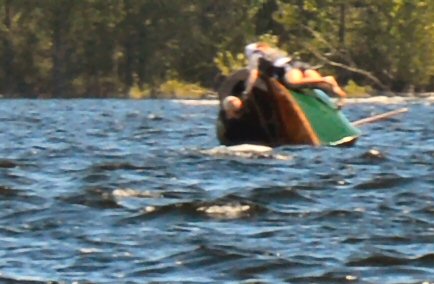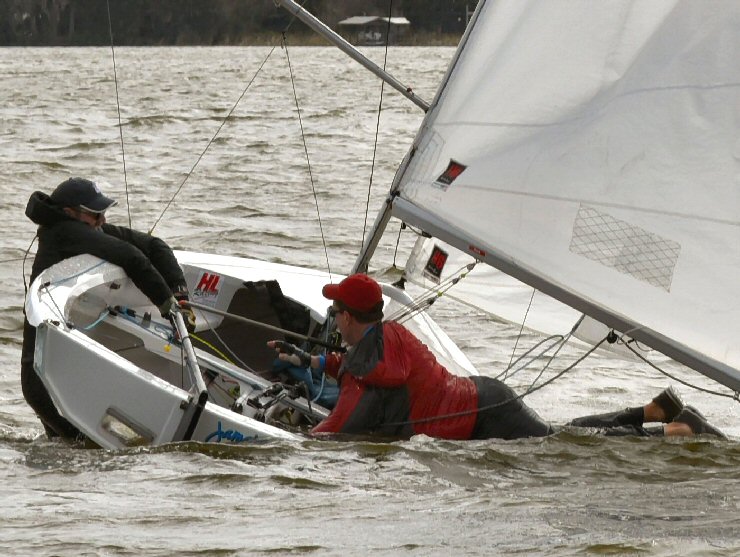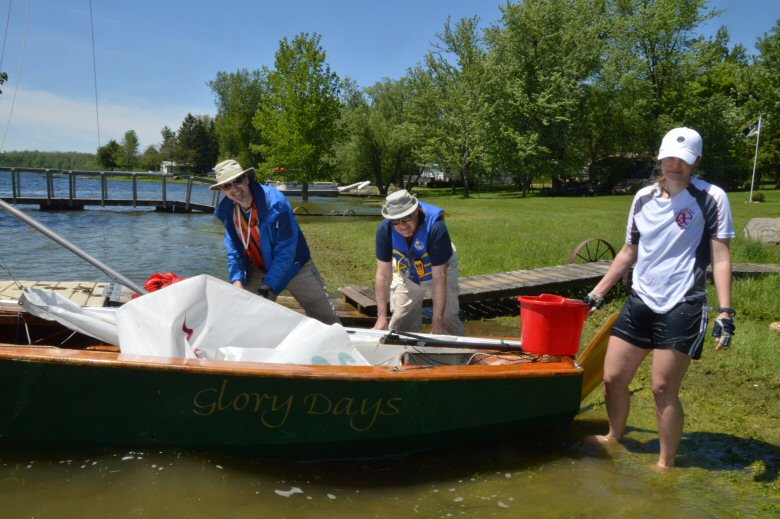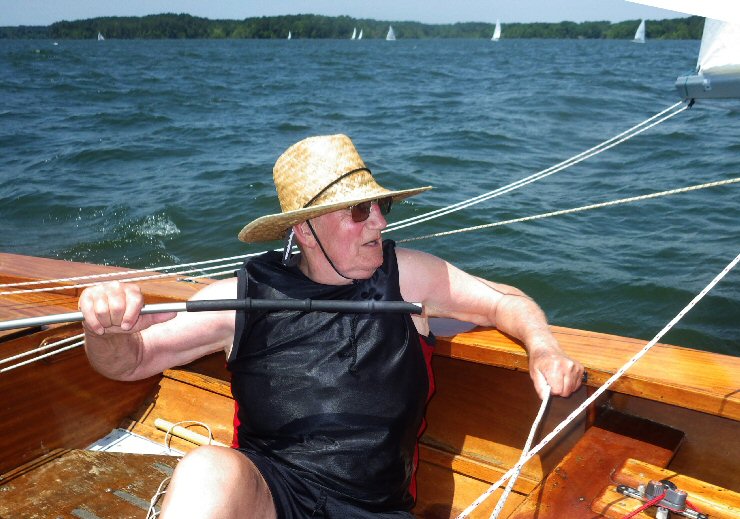Up until recently, I
was
proclaiming far and wide the following fool-proof
approach to
self-rescue after a capsize:
1. right boat using the scoop method (one crew member on
centreboard,
one inside hull as seen below)

Here, Uncle Al and
Shannon have just
capsized because the mainsheet caught on Al's
(unwanted!!!) life
jacket. At this point, life could have been made
simpler if Al had
immediately dropped off the boat into tread-water,
not-touching-the-boat mode to keep the boat from
turning turtle (mast
down) while Shannon moved over to stand on the
board. Instead, Al
panicked and kept clutching the boat until he was
forced to let go of
the boat anyway once our "Greenlander" (as the
Danes call a complete
inversion) became complete. More of this tale
below.
3. If the
centreboard
person is young and/or nimble, (s)he usually flops
into the boat as the
mast nears vertical. For older/weaker crews, boat
re-entry may have to
happen after the mast is vertical. In that case,
the crew
hanging onto the outside of the boat near the centre
thwart
will need help from the inboard person. With the boat
now dead in the
water and sideways to the wind, Inboard can easily and
quite safely
heel the boat until the gunwhale where Outboard's
hanging on, is level
with the water. This permits Outboard to grab a hiking
strap or what
have you and pull him- or herself back aboard (photo below).
4. Bailing can now begin in peace and quiet since the
boat
is totally stable when there is no motion through the
water, no board
down and no sails pulling ...

Dave McCreedy slides
himself back into the
boat. Here, Jamaica Blue has
yet to be stabilized in her capisize recovery mode
(board fully up, spi
down - upper picture, sails
totally free to luff) which will be Dave's first
order of business once
he is inside the boat.
Tony Krauss and
Uncle Al in
capsize-recovery mode. In this mode, it is
perfectly safe to heel the
boat to windward or to leeward until the
gunwhale is in the water and
the crew can slide back aboard, so long as the
boat is not moving
through the water, unless it
turns out that, God forbid, the following should
be the situation:
On Conestogo Lake Saturday 8 June 2019, I discovered, to
my
considerable horror, that my post-capsize cure-all (no
forward motion,
no board, no wind in sails = total peace as in photo
above) is useless
if the aft buoyancy tank has filled with water.
And it was all my fault. I had ignored the fact that one
of my four
snap-fasteners in the aft hatch cover was not
catching/closing. Turns
out that one screw that needed to be flush to the deck
was sticking out
a good half-inch. By the time we (mostly Shannon on the
board) had
recovered from our second turtle, the aft tank was
pretty much useless
as to buoyancy. That is where the horror came in: I
settled back with
sails ragging and board full up and got set to help
Shannon back aboard
only to discover that the boat immediately began yet
another turtle. I
was stunned enough that poor Shannon was pressed
into another
turtle recovery - with an even worse result.
 (l to r) David von
Wahl, David
Morgan, Shannon Donkin
(l to r) David von
Wahl, David
Morgan, Shannon Donkin
Fortunately, we
were by
this time, only about a hundred yards from shore and
were able to get
the safety boat to tow us there with the mast in
capsize (as opposed to
turtle) position since the boat was not stable enough
to be towed
upright. After righting the boat at the water's edge,
we had to back
into shore to get the aft tank out of the water (above). At
about this time we
discovered that my treasured W116 Snoopy
bailing bucket from 1964, the last memento from my
first Wayfarer had
been "lost at sea" because I had not tied it to the
boat. Fortunately,
the rescue team not only provided a couple of big
buckets but also did
a large share of the bailing. Once the water was down
to
floorboard-level, we raised the sailed and arrived at
the club just in
time for lunch.
Lesson learned: Never,
ever leave your buoyancy to chance.

Another, equally important lesson
learned:
Only one week after having been beaten over the
head with the baseball bat reminder,
Al proudly modelled the finest tank top Walmart
has to offer over his mandatory PFD at Kerr Lake.
This has - so far - a perfect record of defeating any
of my mainsheet's attempts at hooking up with my PFD.
|